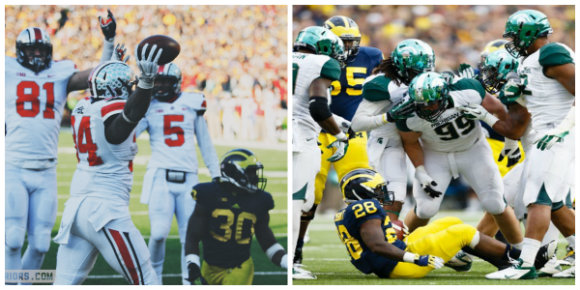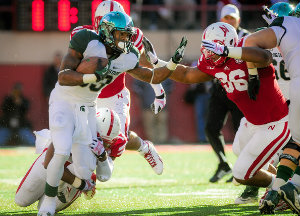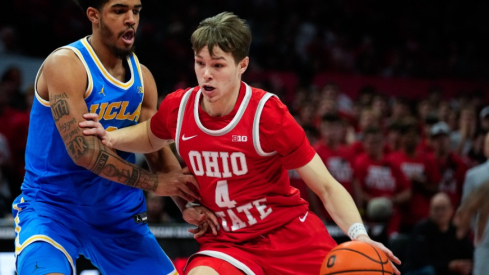
There's no question that Michigan State will be the toughest team that the Buckeyes have faced all season. The dummy statistics show that the Narduzzi-led defense is the best in the country, and as I'll show below, the more advanced metrics tend to agree.
The F/+ rankings have the MSU defense ranked second behind Virginia Tech. Bill Connelly, using the F/+ data, gives Ohio State a 65.5% win probability and a projected score of 28-23. However, he notes that,
A turnover is worth about five equivalent points on average, which means that the results of six of the seven conference championships above could be flipped by a single interception or fumble.
It is imperative that the Buckeyes have a positive or at least neutral turnover margin this Saturday.
Let's Talk About That Defense
According to Brian Kelly, Michigan State's defense is not only the top in the country, but an insurmountable force:
"There's apparently no weaknesses in our estimation as you attack them. You try to get big-chunk plays. You try to push the ball down the field because you cannot win a battle at the line of scrimmage."
It seems to me what he's saying is that opposing offenses have to try for explosive plays, because MSU's aggressive safety play and stellar defensive line play will lead to low running back success rates and poor drive efficiency. What do the statistics say?
| PPP | YPP | YPA | PlPP | PoPP | Ex. Plays | Turnovers | Red Zone TD % | |
|---|---|---|---|---|---|---|---|---|
| MSU Defense | .187 | 20.2 | 3.77 | 4.88 | .910 | 32 (4th) | +12 | 43.5% |
| OSU Offense | .666 | 11.0 | 7.33 | 8.71 | 3.80 | 75 (20th) | +6 | 83.9% |
- A couple of notes about the chart above: PLPP stands for average plays per possession and POPP stands for points per possession. Now we have a better understanding of drive efficiency in addition to play efficiency.
- Nebraska is one of the top rushing offenses that MSU has seen, and the MSU defense allowed 182 yards for 5.7 yards per carry in that matchup. For a comparison, the Buckeyes average 7.1 yards per carry and are second in the nation in rushing yards per game behind Army. Nebraska's Ameer Abdullah had a 64% success rate, which is a very efficient game. In fact, Nebraska managed two of MSU's five runs of 20+ yards this season.
- The Spartans are extremely proficient at preventing explosive rushing plays, but that is partly a function of their opposing rushing offenses. Here are the S&P rushing rankings of MSU's opponents:
| W. MICh | S. FLA | Notre Dame | Iowa | IND | Purdue | ILLI | UM | NEB | NW | MINN | |
|---|---|---|---|---|---|---|---|---|---|---|---|
| Opp RUSH S&P+ Rank | 118 | 100 | 24 | 54 | 4 | 85 | 22 | 65 | 14 | 37 | 71 |
- While Nebraska found success against the Spartan's rushing defense, Indiana did not. Looking closer at that game's box score, the overall team yards per carry is brought down significantly by sacks – Indiana's Coleman actually averaged 5.3 yards per carry.
- All in all, Michigan State has faced two great, three good, and seven very bad rushing offenses. Nebraska and Indiana both managed to have efficient, if not prolific, rushing performances. However, the Spartan defense truly has yet to face a rushing offense on Ohio State's level – mainly because there aren't very many in the country.
- Turnover margin is not just about defenses, but it is worth discussing here because MSU's defense has 27 takeaways on the season. That's 12th in the country in terms of turnovers forced, and 5th in the country in turnovers by the MSU defense. The point being that if turnovers play as big a role as Connelly's projections suggest (i.e. five points allowed per turnover), then that simply underscores how important ball security will be for the Buckeyes. Thank goodness for playing in that dome.
- Take some solace in the fact that the Buckeyes are actually pretty exceptional in ball security as well. The offense is ranked in the top twenty for fewest turnovers lost, while the defense has been fairly proficient with interceptions.
- Herman-Narduzzi is definitely the top matchup of the game, and we'll see the best of their chess match in the red zone. The Buckeyes ascended to the top spot in red zone touchdown percentage after loitering in the top-3 for much of the season, while the Spartans are sixth in opponent red zone touchdown percentage.
Defensive Edge
Few are talking about this matchup, though Conner Cook has steadily improved throughout the season.
| PPP | YPP | YPA | PLPP | POPP | Ex. Plays | Red Zone TD % | |
|---|---|---|---|---|---|---|---|
| MSU Offense | .412 | 12.9 | 5.33 | 5.67 | 2.34 | 49 (84th) | 55.6% |
| OSU Defense | .285 | 17.6 | 5.01 | 5.57 | 1.59 | 37 (11th) | 65.8% |
Here are some notes courtesy of the Ohio State Athletic Department:
| Opponent | Avg. Yards | Actual Yards | Difference |
|---|---|---|---|
| Wisconsin | 349.5 | 104 | -245 |
| Northwestern | 249 | 155 | -94 |
| Iowa | 207.5 | 130 | -77 |
| Penn State | 157.2 | 120 | -37 |
| Purdue | 76.1 | 27 | -49 |
| Illinois | 136.4 | 132 | -2 |
| Indiana | 189.9 | 122 | -67 |
 Jeremy Langford has been dependable
Jeremy Langford has been dependable In Big Ten play Ohio State has shut down the run. The Buckeyes held No. 23 Wisconsin to 104 rushing yards -- 245 yards below its season average. The very next week Ohio State held No. 15 Northwestern to 155 yards below its average of 249 yards per game. Against Iowa, Ohio State held the Hawkeyes to 130 yards on the ground, 77 yards below its season average, before holding Penn State to 120 yards, 37 below its average. The Buckeyes then allowed just 27 rushing yards in the 56-0 win at Purdue and held Indiana 67 yards below its average.
- My only real concern about the Michigan State offense – the one led by Mr. Bollman – is an overabundance of runningback screens on passing downs against over-pursuing defenders. Here's what that looks like.
- Michigan State's offense is not really built to create explosive plays, nor does it average a high number of plays per drive. This indicates that the Spartans score primarily by playing field position. If that sounds familiar, it's because it's called TresselBall. Michigan State is ranked second on Football Outsider's overall field position FEI rankings, and first in the country in "Starting Field Position Delta" which is the difference between one's opponents and own starting field position. Michigan State's average starting field position is the 33 yard line.
- Further, MSU's excellent field position is not a function of their special teams, which are good but not exceptional. Instead, it's the defense that puts the offense is such excellent field position. Without that, the Michigan State offense has not shown the ability to consistently produce extremely long drives, nor big chunks of yards on explosive plays.
- Fun fact: Carlos Hyde leads the country in yards per carry (7.81 YPC) during conference play for runningbacks with at least ten attempts per game. Another fun fact? Braxton Miller is fourth in that category with 7.1 YPC.
- Langford has picked up steam lately in conference play, topping six yards per carry against Northwestern and Minnesota. He has 31 rushes of 10+ yards and six of 20+ yards. For a comparison, Hyde has 40 and eleven.

